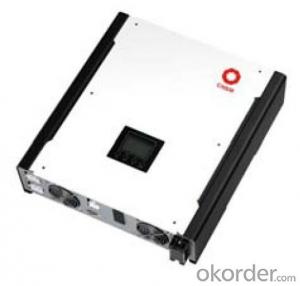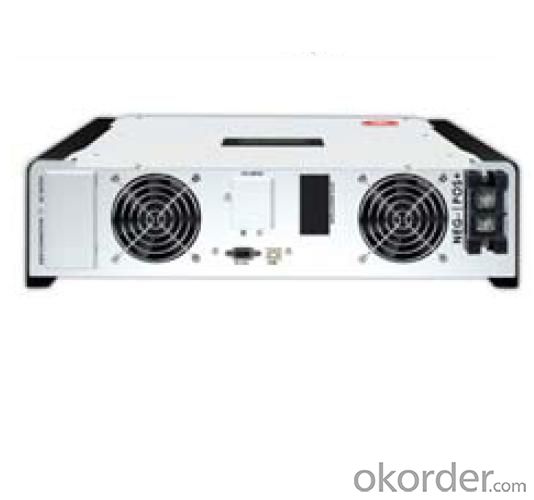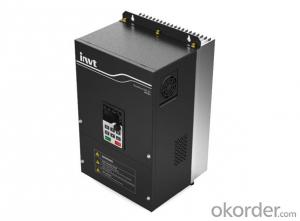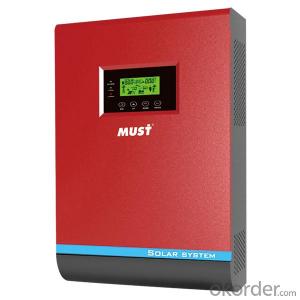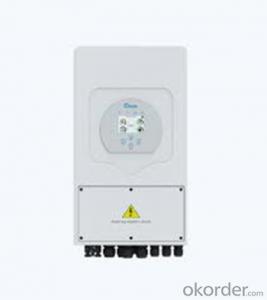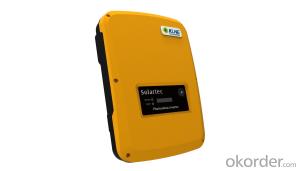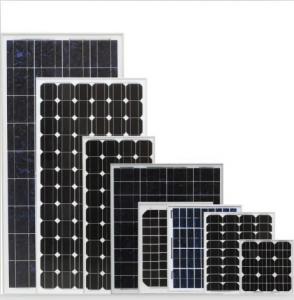12 Kw Solar Inverter Hybrid Inverter Sunbrid 2000 with Full Certificate
- Loading Port:
- Guangzhou
- Payment Terms:
- TT OR LC
- Min Order Qty:
- 10 pc
- Supply Capability:
- 3000 pc/month
OKorder Service Pledge
OKorder Financial Service
You Might Also Like
Sunbrid 2000/3000 hybrid solar inverter can be use as on grid solar inverter or off grid inverter.
1.futures
Multiple operations: Grid-tied, off-grid, and grid-tied with battery backup
•Solar power usage priority selectable
•Built-in MPPT solar charger
•Intelligent control to guarantee stable system charging
•Comprehensive information from LCD display
2.datasheet
| MODEL | Sunbrid 2000 | Sunbrid 3000 |
| RATED POWER | 2000 W | 3000 W |
| GRID-TIE OPERATION | ||
| PV INPUT (DC) | ||
| Nominal DC Voltage | 300 VDC | 360 VDC |
| Maximum DC Voltage | 350 VDC | 500 VDC |
| Start-up Voltage / Initial Feeding Voltage | 80 VDC / 120 VDC | 116 VDC / 150 VDC |
| MPP Voltage Range | 120 VDC ~ 320 VDC | 120 VDC ~ 450 VDC |
| Maximum Input Current | 15 A | 13 A |
3.product certificate
CE,
ISO2000
TUV
4.product outlook
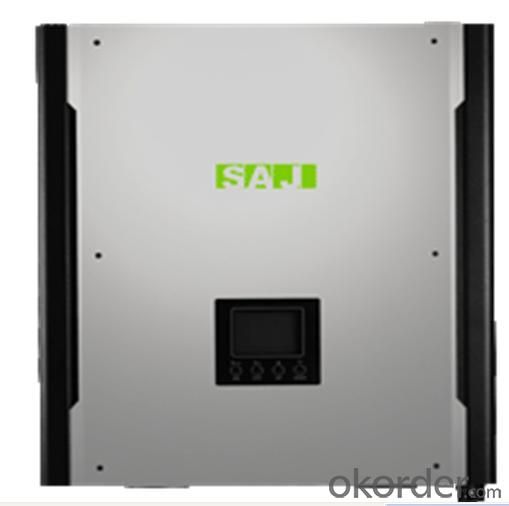
FAQ
1. How long will my inquiry get response?
Your inquiry related to our products or prices will be replied within 24 hours.
2. Can I get professional service and suggestion?
Well-trained and experienced staffs to answer all your questions in fluent English.
3. Do you accept OEM or customized design?
OEM & ODM, any your customized lightings we can help you to design and put into product.
4. What if I need specific design?
Distributorship are offered for your unique design and some our current models.
- Q: Are solar inverters compatible with different solar panel technologies?
- Yes, solar inverters are generally compatible with different solar panel technologies. However, it is important to ensure that the inverter's specifications and capabilities align with the specific requirements of the solar panels being used. Some inverters may be optimized for certain panel technologies, so it's advisable to consult with manufacturers or experts to ensure compatibility and maximize system efficiency.
- Q: How long does a solar inverter last?
- A solar inverter typically has a lifespan of around 10 to 15 years, although this can vary depending on various factors such as the quality of the inverter, its usage, and maintenance.
- Q: How do you calculate the maximum power point tracking efficiency for a solar inverter?
- To calculate the maximum power point tracking (MPPT) efficiency for a solar inverter, you need to compare the actual power output of the inverter with the maximum power point (MPP) of the solar panel. It can be calculated by dividing the actual power output by the MPP power and then multiplying the result by 100 to get the efficiency in percentage. The formula is: MPPT efficiency = (Actual Power Output / MPP Power) * 100.
- Q: Can a solar inverter be used in systems with different module orientations?
- Yes, a solar inverter can be used in systems with different module orientations. Solar inverters are designed to convert the direct current (DC) generated by the solar panels into alternating current (AC) that can be used to power electrical devices. They are compatible with various module orientations, including both portrait and landscape orientations. However, it is important to consider the efficiency and performance of the solar system when installing modules with different orientations, as it may affect the overall energy production.
- Q: Can a solar inverter be used with a hybrid solar power system?
- Yes, a solar inverter can be used with a hybrid solar power system. A hybrid solar power system typically consists of both solar panels and a secondary power source, such as batteries or a diesel generator. The solar inverter converts the direct current (DC) power generated by the solar panels into alternating current (AC) power that can be used to power appliances and devices in the home or business. Additionally, the solar inverter can also manage the flow of power between the solar panels, the batteries, and the grid, optimizing energy usage and ensuring a reliable power supply.
- Q: How does the input power rating affect the performance of a solar inverter?
- The input power rating of a solar inverter directly affects its performance. A higher input power rating allows the inverter to handle a greater amount of solar energy, resulting in a higher energy conversion efficiency and overall performance. On the other hand, a lower input power rating may limit the inverter's capacity to handle larger solar systems, potentially leading to lower efficiency and reduced performance. Therefore, selecting an inverter with an appropriate input power rating is crucial to ensure optimal performance in a solar energy system.
- Q: Can a solar inverter be used in regions with high levels of dust or debris?
- Yes, a solar inverter can be used in regions with high levels of dust or debris. However, it is important to regularly clean and maintain the inverter to ensure optimal performance and prevent any damage caused by the accumulation of dust or debris.
- Q: How does a solar inverter handle different temperature conditions?
- A solar inverter is designed to handle different temperature conditions by employing various thermal management techniques. It typically has built-in cooling systems such as fans or heat sinks to dissipate excess heat. Additionally, advanced inverters may employ temperature sensors to monitor the internal temperature and adjust their operations accordingly. These temperature compensation features allow the inverter to maintain optimal performance and efficiency across a wide range of temperature conditions.
- Q: What safety features should a solar inverter have?
- A solar inverter should have several safety features, including overvoltage protection, overcurrent protection, ground fault protection, and arc fault protection. Additionally, it should have robust insulation to prevent electrical shock hazards and be equipped with sensors to monitor temperature and prevent overheating. Finally, it should have a secure enclosure to protect against environmental factors such as water, dust, and debris.
- Q: How do you choose the right size of solar inverter for a system?
- When choosing the right size of solar inverter for a system, it is important to consider the total capacity of the solar panels and the expected power output. The inverter should have a capacity that matches or slightly exceeds the maximum power output of the panels to ensure optimal efficiency. Additional factors such as the type of grid connection and any future expansion plans should also be taken into account. Consulting with a professional solar installer or conducting a thorough system assessment can help determine the appropriate size of the inverter for a given solar system.
Send your message to us
12 Kw Solar Inverter Hybrid Inverter Sunbrid 2000 with Full Certificate
- Loading Port:
- Guangzhou
- Payment Terms:
- TT OR LC
- Min Order Qty:
- 10 pc
- Supply Capability:
- 3000 pc/month
OKorder Service Pledge
OKorder Financial Service
Similar products
Hot products
Hot Searches
Related keywords
